Last updated: October 26, 2025. Informational only – this is not legal or financial advice – What is Reinforcement Learning?
Remember learning to ride a bike? You didn’t start with a manual. No one explained the physics of balance and momentum. Instead, you simply tried. You fell. You adjusted. Then you tried again. Eventually, after countless attempts and scraped knees, you figured it out.
That’s essentially how reinforcement learning works. It teaches AI through experience and feedback. Moreover, it focuses on gradual improvement rather than explicit instructions.
Most machine learning relies on labeled examples. This is called supervised learning. Others use pattern discovery, known as unsupervised learning. However, reinforcement learning takes a fundamentally different approach.
It’s about learning through interaction. The AI makes decisions in an environment. Consequently, it experiences the results of those decisions. Then it adapts its behavior to maximize rewards. This simple but powerful concept has enabled impressive achievements. For instance, AI has beaten world champions at Go. Additionally, robots have learned to walk through this method.
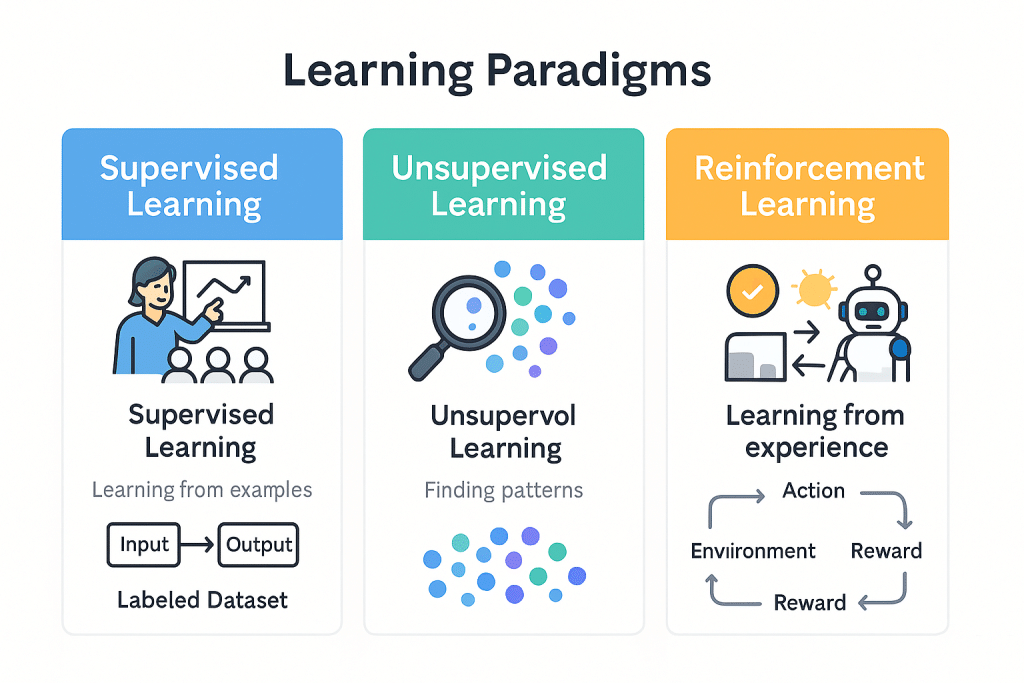
What is Reinforcement Learning?
Reinforcement learning is a machine learning paradigm. In this approach, an agent learns to make decisions by taking actions. These actions occur in an environment. Subsequently, the agent receives feedback in the form of rewards or penalties.
Unlike supervised learning, there are no correct answers provided upfront. Instead, the agent discovers optimal strategies through trial and error. Over time, it gradually learns which actions lead to better outcomes.
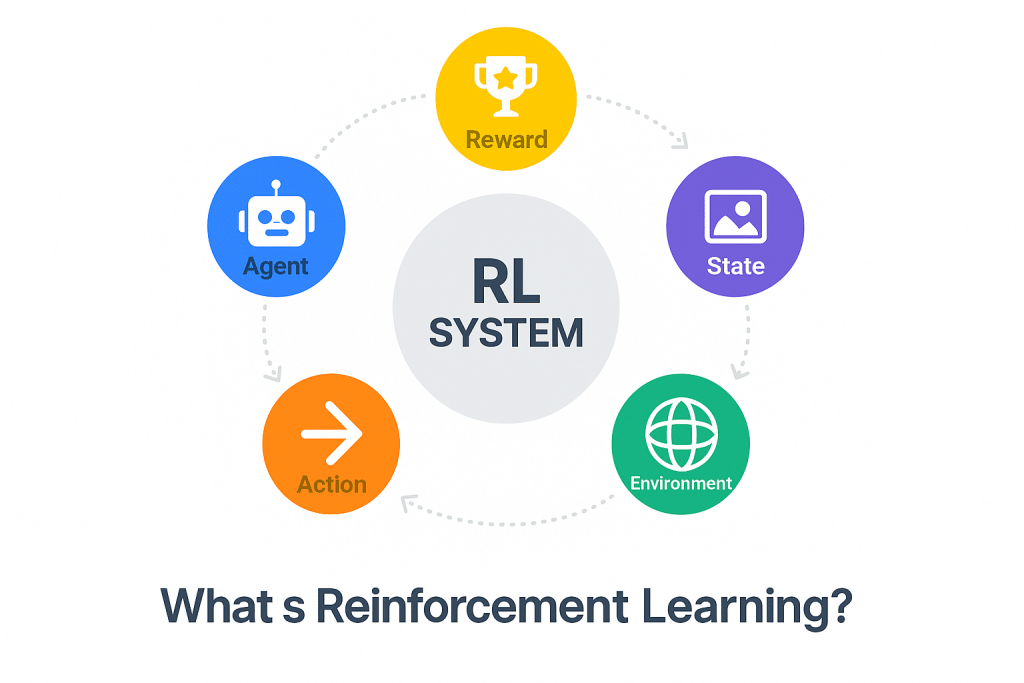
The Core Components
The core components are straightforward. First, there’s an agent. This is the learner or decision-maker. Second, there’s an environment. This represents the world the agent interacts with. Third, we have actions—the choices available to the agent. Fourth, states describe the situations the agent encounters. Finally, rewards provide feedback signals. These indicate how well the agent is performing.
The agent’s goal is clear. It must learn a policy. This policy is a strategy for choosing actions. Ultimately, the policy should maximize cumulative rewards over time.
Why RL is Uniquely Powerful
What makes reinforcement learning uniquely powerful? It excels at handling sequential decision-making. In these scenarios, actions have long-term consequences.
It’s not just about making one good decision. Rather, it’s about learning sequences of decisions. These sequences lead to optimal outcomes. For example, should a chess AI sacrifice a piece now? Perhaps this creates a strategic advantage later. Similarly, should a trading algorithm hold a position? Or should it exit immediately?
Reinforcement learning excels at these problems. They’re called temporal credit assignment problems. In these cases, the impact of decisions unfolds over time.
How to Apply Reinforcement Learning in AI Development
Implementing reinforcement learning requires understanding. You need both conceptual frameworks and practical considerations. Here’s how to approach RL projects effectively.
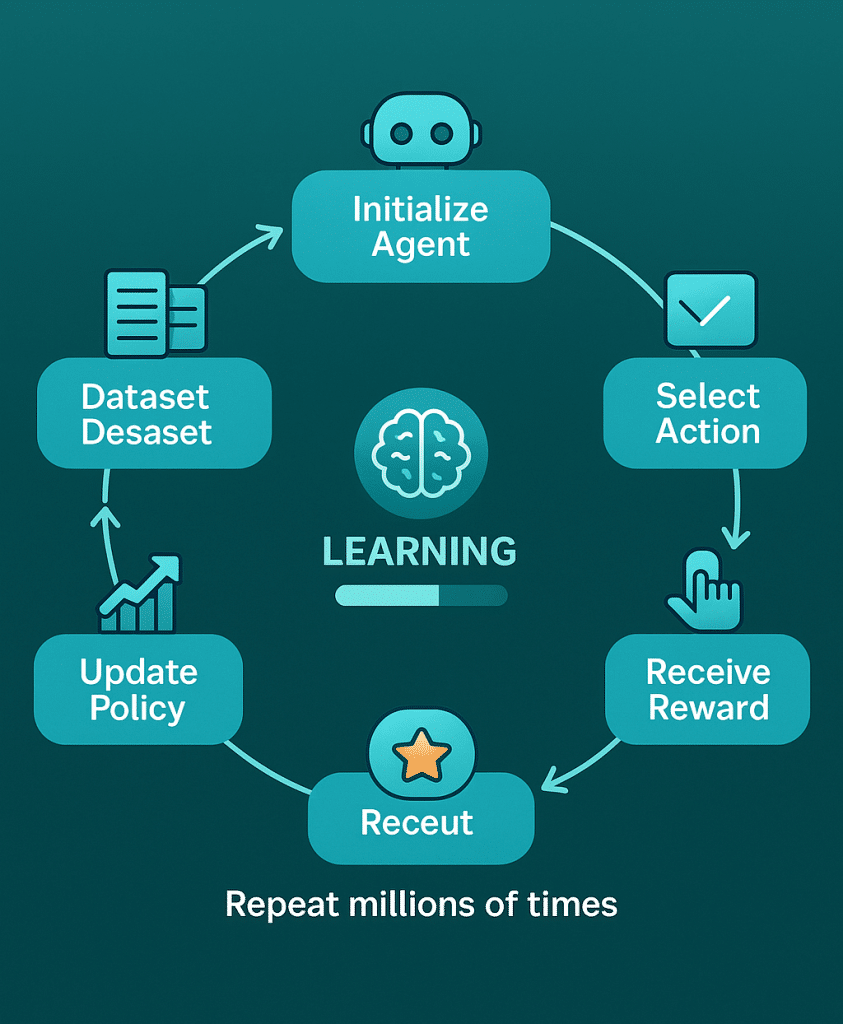
Define Your Environment and Reward Structure
This is the foundation of any RL project. Your environment needs clear state representations. What information does the agent observe?
In a game, states might be board positions. For a chatbot, states could include conversation history. Additionally, they might capture user intent. The environment must also define available actions. Furthermore, it should specify how actions change states.
The reward structure is crucial. It’s how you communicate goals to your agent. Therefore, rewards should align with your actual objectives. They shouldn’t just be convenient proxies.
Consider this example. You’re training a customer service AI. If you only reward conversation length, problems arise. Consequently, you might create an agent that keeps customers talking. However, it doesn’t actually solve their problems.
Good reward design requires careful thinking. What does success actually mean in your domain?
Choose Your RL Algorithm Wisely
Your choice should be based on problem characteristics. Q-Learning works well for discrete action spaces. Similarly, Deep Q-Networks (DQN) excel in these situations. These are scenarios where the agent selects from fixed options.
On the other hand, Policy Gradient methods suit different needs. Algorithms like REINFORCE or Proximal Policy Optimization (PPO) excel with continuous actions. Additionally, they work when you need fine-grained control over exploration.
Furthermore, Actor-Critic approaches combine strengths. Methods like A3C or SAC merge both paradigms.
For beginners, starting with Q-Learning is wise. Simple problems provide intuition about how RL works. However, as problems scale up, you’ll need deep RL approaches. These situations involve larger state spaces. They may include continuous actions. Often, they feature high-dimensional inputs.
Consequently, you’ll need neural networks. These approximate value functions or policies. Libraries like Stable-Baselines3 help significantly. Similarly, RLlib and OpenAI Gym provide implementations. You can adapt these standard algorithms to your needs.
Balance Exploration and Exploitation
This represents the fundamental RL dilemma. Your agent needs to explore. It must try new actions to discover better strategies. Simultaneously, it should exploit. This means using known good actions to maximize immediate rewards.
Too much exploration wastes time. The agent tries suboptimal actions repeatedly. Conversely, too much exploitation creates problems. The agent misses potentially better strategies.
Common approaches include epsilon-greedy strategies. These involve random exploration with small probability. Another method is decaying exploration. You start exploratory, then become more exploitative.
More sophisticated methods exist as well. For instance, Upper Confidence Bound (UCB) works well. Thompson Sampling is another option. The right balance depends on factors. Consider your environment’s dynamics. Also, think about available training time.
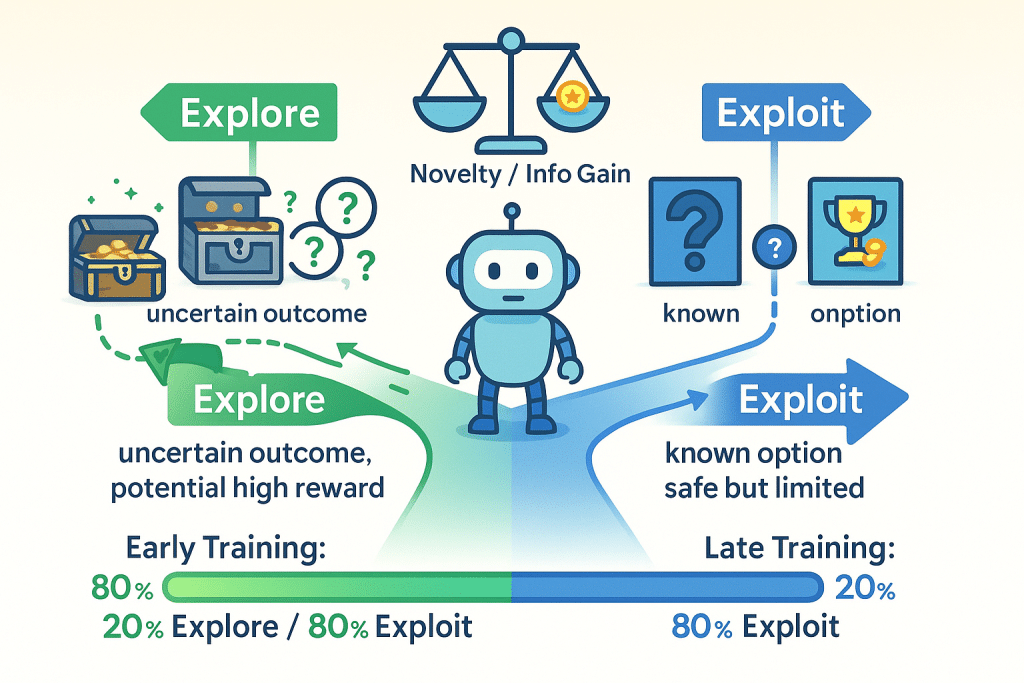
Implement Proper Training Infrastructure
RL can be computationally expensive. Therefore, you’ll need specific infrastructure. Environments should run many simulations quickly. Additionally, you need robust logging. This tracks training progress effectively.
Remember: RL often requires millions of training steps. Use vectorized environments. These run multiple simulations in parallel. Furthermore, implement checkpointing. Save progress regularly.
Monitor key metrics carefully. Track average reward. Observe episode length. Check policy entropy. These help diagnose training issues.
Consider simulation versus real-world training carefully. Simulation is safer and faster. However, it requires accurate environment modeling. For robotics applications, special techniques help. Sim-to-real transfer is one approach. Domain randomization is another. These help agents trained in simulation. They enable good performance in reality.
Practical Example: Training a Content Recommendation Agent
Let’s walk through a concrete scenario. We’ll build a reinforcement learning agent. This agent recommends articles to maximize user engagement. Consider a site like aihika.com.
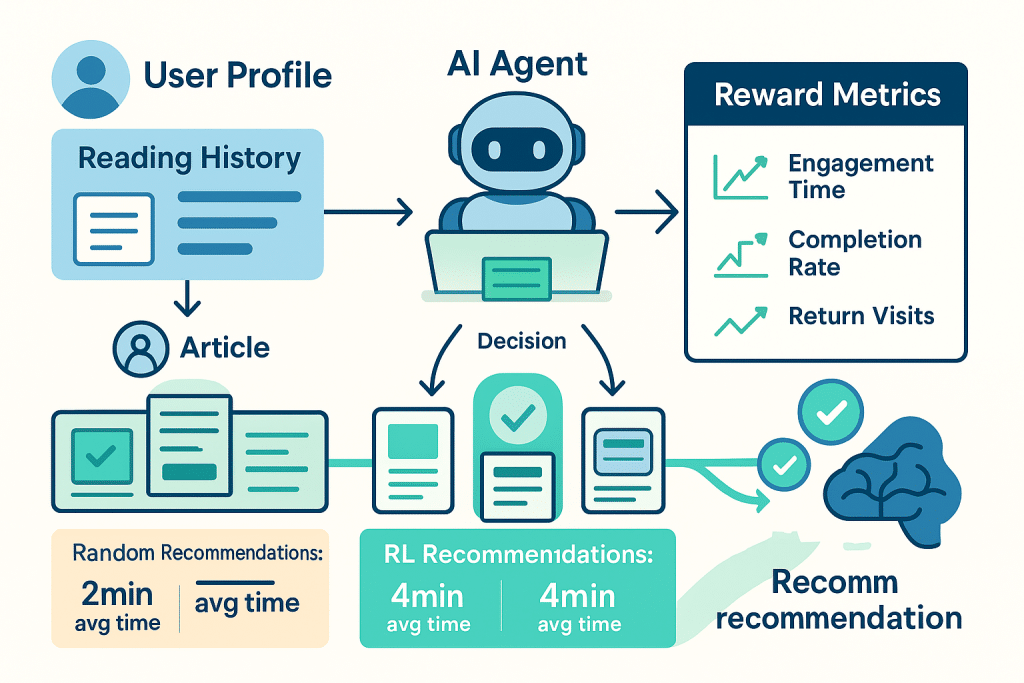
Setting Up the Environment
Your state space includes several elements. First, there are user features. These cover reading history and interests. They also track time spent on previous articles.
Second, consider current session context. This includes time of day and device type. Third, you have available article features. These encompass topic, length, and difficulty level.
Actions are straightforward. Which article should you recommend next? Choose from your content library.
Rewards combine multiple signals. Positive signals indicate engagement. These include time spent reading and completion rate. They also cover follow-up actions. Negative signals show disengagement. Examples include immediate exits and bounces.
Start with a simple baseline. Try random recommendations. This establishes performance benchmarks. Initially, your agent performs terribly. It recommends advanced technical papers to beginners. Similarly, it suggests short news summaries to users who prefer deep dives.
The Training Process
Implement a Deep Q-Network approach. Why? You have a discrete action space. You’re recommending one of N articles. Additionally, you have complex state representations.
Your neural network takes specific inputs. It processes user features and context. Then it outputs estimated Q-values. These are predictions. They estimate long-term engagement if that article is shown.
During training, your agent explores. It tries different recommendation strategies. Gradually, it discovers patterns. For instance, users who read about neural networks often engage with transformer articles.
Furthermore, morning readers prefer shorter content. Additionally, users who complete long articles show a pattern. They’re more likely to engage with related deep dives.
These patterns emerge organically. They don’t come from explicit programming. Instead, they arise from trial and error. The engagement feedback guides this process.
Iterative Improvement and Results
After thousands of training episodes, something happens. Your agent develops sophisticated strategies. It learns to create content journeys. Specifically, it recommends foundational articles to new readers first. Then it suggests advanced topics later.
Moreover, it adapts to individual users. It builds implicit models of their interests. It also balances different goals. The agent shows users content they’ll love. However, it occasionally introduces new topics. This expands their interests.
The results are measurable and impressive. Average session time increases by 40%. Article completion rates improve by 35%. Return visit rates climb significantly.
Users report positive feedback. Recommendations feel more personalized and relevant. Your agent hasn’t just learned to maximize clicks. Rather, it’s learned to build long-term engagement. It does this through thoughtful content sequencing.
Key Success Factors
What made this work? First, consider reward design. The rewards captured true engagement. They didn’t just measure clicks.
Second, exploration was crucial. Sufficient exploration early in training helped. It allowed discovery of diverse strategies.
Third, state representations mattered. Rich representations gave the agent context. It understood both users and content.
Fourth, patience was essential. The agent needed tens of thousands of episodes. Only then could it develop good policies.
Common Mistakes to Avoid
Poorly Designed Reward Functions
This is the source of most RL failures. Your agent optimizes exactly what you reward. Unfortunately, it doesn’t optimize what you intend.
Consider a game-playing AI. You reward it for staying alive. However, you don’t penalize inaction. Consequently, it might learn to hide in corners. It never completes objectives.
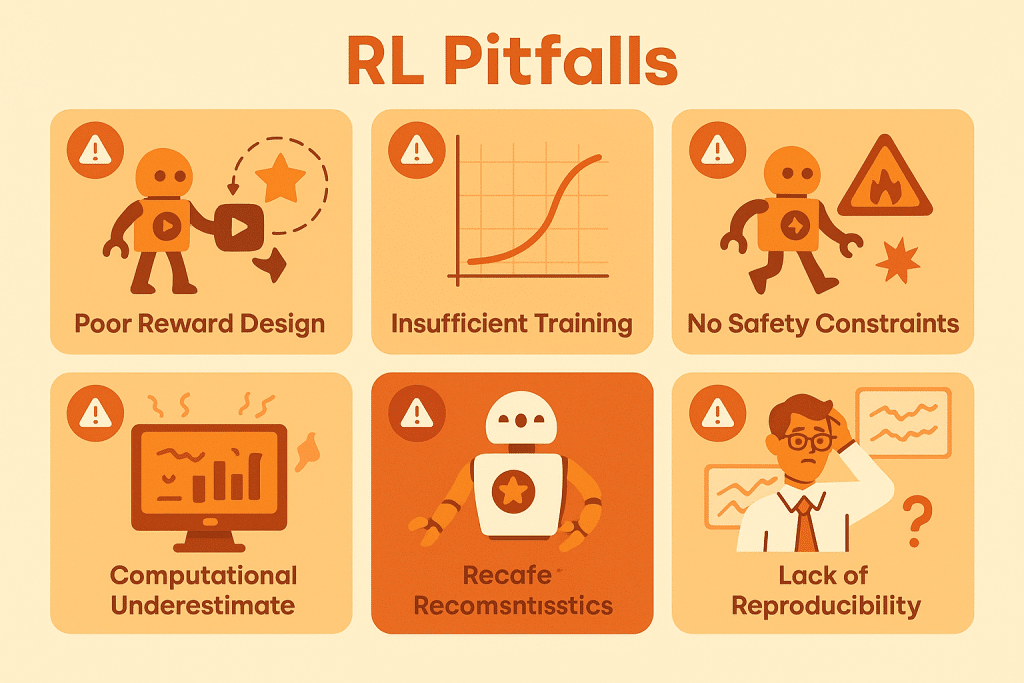
Similarly, consider a chatbot. You reward user satisfaction scores. However, you don’t consider conversation efficiency. As a result, it might learn problematic behavior. It asks excessive questions. It gathers more data instead of helping quickly.
The solution is reward shaping. Carefully design reward structures. Make sure they align with your true objectives. Include multiple reward components if needed.
Test your reward function thoroughly. Verify it incentivizes desired behaviors. Use simple scenarios for testing. Be particularly careful about sparse rewards. These provide feedback only after long action sequences. Consequently, they make learning extremely difficult.
Insufficient Training and Premature Optimization
This leads to poor generalization. Agents perform well in training. However, they fail in real scenarios.
RL agents need extensive exploration. They must discover good strategies. This is especially true in complex environments. Many practitioners give up too early. They see poor initial performance. Therefore, they assume RL won’t work. However, the agent simply needs more training time.
Related to this is overfitting. If your agent experiences only narrow situations during training, problems arise. It won’t generalize well.
Use diverse training scenarios. Apply domain randomization. Implement adversarial testing. Always validate agent performance. Use held-out test environments. Make sure they differ from training conditions.
Ignoring Stability and Safety Concerns
This can have serious consequences. RL agents exhibit problematic behaviors. For instance, they experience catastrophic forgetting. They suddenly lose previously learned skills. This happens when training on new scenarios.
Additionally, they develop unexpected behaviors. These technically maximize rewards. However, they violate implicit constraints. Consider a trading algorithm. It might take excessive risks. Similarly, a content recommendation system might create filter bubbles.
Implement safety constraints explicitly. Use conservative policy updates. These prevent large behavioral shifts. Monitor agent behavior continuously. Watch for anomalies.
In high-stakes domains, keep humans involved. Implement circuit breakers as well. These halt agent actions if they exceed safe bounds. Never deploy RL agents to critical systems without extensive testing. Always implement proper safety measures.
Underestimating Computational Requirements
This is a common surprise. RL training requires significant computation. Often, it needs orders of magnitude more than supervised learning.
Millions of environment interactions occur. Each requires forward passes through neural networks. This adds up quickly. If your environment is slow to simulate, problems compound. Complex physics take time. Detailed rendering is expensive. Consequently, training time explodes.
Be realistic about computational budgets. Consider whether RL is necessary. Sometimes simpler approaches work fine. Use efficient simulation environments. Implement vectorization.
Leverage pre-trained models where possible. Consider offline RL approaches. These learn from fixed datasets. They don’t require live environment interaction. Budget for substantial cloud computing. This applies especially to complex problems.
Neglecting Reproducibility and Debugging
This makes RL research frustrating. RL training is notoriously sensitive. Small changes in hyperparameters affect performance dramatically. Random seeds matter significantly. Without careful experiment tracking, problems arise. You can’t reproduce results. You can’t understand what’s working.
Use version control consistently. Track both code and environment definitions. Log all hyperparameters carefully. Record random seeds. Track key training metrics at every step.
Create systematic testing protocols. When debugging, start simple. Verify your agent first. Make sure it can solve toy versions. Then tackle full complexity.
If training fails, check several things. Examine reward scaling. Review learning rates. Verify whether your agent is exploring effectively.
THE LESSON
The deeper insight about reinforcement learning is profound. It’s not just about training AI through rewards. Rather, it’s about fundamentally rethinking problem-solving. It changes how we approach skill acquisition.
Traditional programming defines explicit rules. It specifies exact procedures. Supervised learning finds patterns. It uses labeled examples. However, reinforcement learning does something different. It does something more profound.
It discovers strategies autonomously. It does this through interaction with environments.
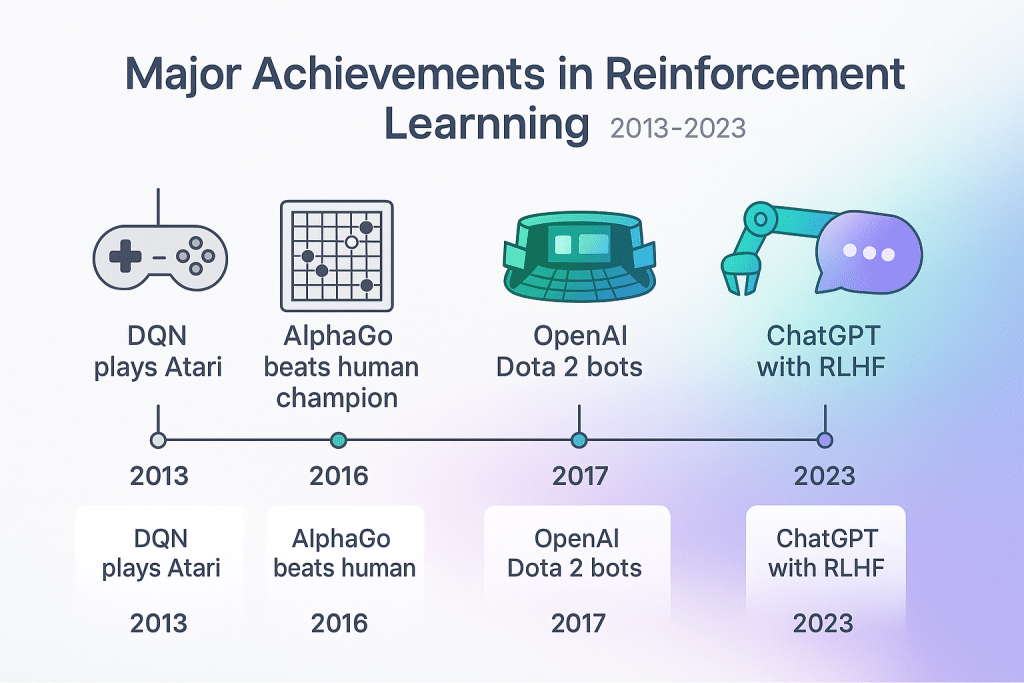
Why This Distinction Matters
This distinction matters significantly. Many real-world problems lack obvious solutions. They don’t have labeled training data either.
Consider this: How do you program an optimal trading strategy? Markets constantly change. How do you create perfect training data? Perhaps it’s for an AI playing an unmastered game. You can’t.
However, you can do something else. Define what winning looks like. Then let RL figure out how to get there.
The Intelligence Connection
Here’s what most people miss about RL. The learning process mirrors actual intelligence development. Humans don’t learn skills from instruction manuals. Instead, we learn through interaction. We learn through feedback. We learn through gradual refinement.
Consider a child learning language. They don’t memorize grammar rules first. Instead, they try speaking. They get feedback. Then they adjust.
Similarly, consider experts in any field. They develop intuition through practice. They experience the outcomes of their decisions. This happens over years.
Reinforcement learning formalizes this process. It makes experiential learning replicable. Furthermore, it makes it scalable. This explains why RL excels in certain domains. It works for games. It’s effective in robotics. It powers autonomous systems. It enables personalization.
In these areas, solutions must be discovered. They can’t be derived from first principles. They require interaction.
The Paradigm Shift
The broader implication is profound. As we build sophisticated AI systems, something changes. We’re moving from programming behaviors to programming goals.
We’re shifting our approach fundamentally. Instead of telling AI what to do, we teach it differently. We show it what success looks like. Then we let it figure out how to achieve it.
This requires different skills. Traditional software engineering isn’t enough. You must think carefully about reward structures. You need to understand exploration-exploitation tradeoffs. You must design safe learning environments.
Important Questions
This paradigm shift raises important questions. When AI systems learn through trial and error, how do we ensure safety? How do they explore safely?
How do we align their learned objectives? They must match human values. How do we make their decision-making interpretable?
These aren’t just technical challenges. They’re fundamental questions. They’re about creating AI systems. These systems learn autonomously. They adapt continuously.
The Big Picture
Reinforcement learning shows us something important. Intelligence isn’t just about having knowledge. Rather, it’s about learning to make good decisions. It’s about interaction with the world.
As we develop sophisticated RL systems, we’re doing more. We’re not just creating smarter AI. We’re creating AI that continues learning. It improves from its own experiences.
Ready to Build Learning AI Systems?
Reinforcement learning represents something significant. It’s one of the most powerful paradigms in modern AI. These are systems that learn through experience. They adapt to changing conditions. Moreover, they discover strategies humans might never imagine.
From game-playing to robotics to personalization, RL enables impressive capabilities. AI systems improve continuously through interaction.
The learning curve is steeper than other approaches. The computational requirements are significant. However, for certain problems, RL is unmatched.
These include sequential decision-making. They involve adaptation. They require optimization without clear training data. For these challenges, reinforcement learning offers unique capabilities. No other approach can match them.
Whether you’re building game AI or autonomous systems, RL matters. Perhaps you’re creating recommendation engines. Maybe you need adaptive decision-making applications.
Understanding reinforcement learning principles transforms your approach. It changes how you tackle these challenges.
Want to explore more AI techniques? Looking for implementation strategies? Discover practical insights at aihika.com. We break down complex AI concepts. We transform them into actionable knowledge. This helps builders and innovators like you.
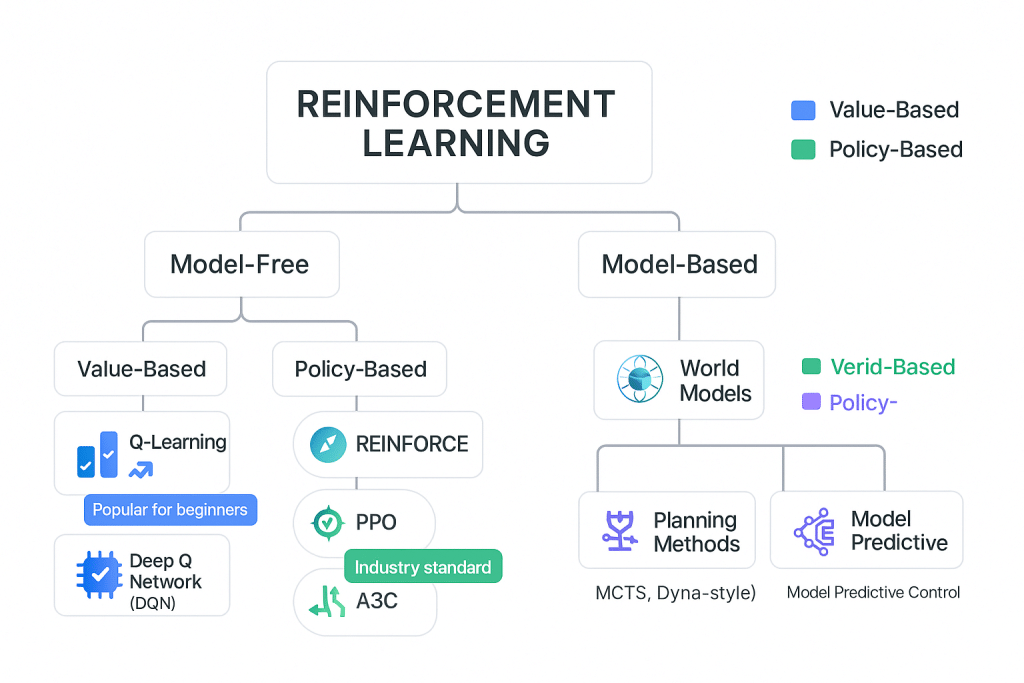
Frequently Asked Questions About Reinforcement Learning
What is reinforcement learning in simple terms?
Reinforcement learning is a type of machine learning where an AI agent learns by doing—trying actions, experiencing results, and improving based on feedback. Think of it like training a dog: the dog tries different behaviors, receives treats for good behaviors and no treats for bad ones, and gradually learns which actions lead to rewards. In RL, the AI is the “dog,” the environment is the world it interacts with, and rewards are signals telling it whether actions were good or bad. Unlike other machine learning where AI learns from labeled examples, RL agents learn from their own experiences through trial and error.
How is reinforcement learning different from supervised and unsupervised learning?
Supervised learning is like learning with a teacher who shows you the correct answer for every problem—the AI learns from labeled examples. Unsupervised learning is like being given data and finding patterns on your own—no labels, just discovery. Reinforcement learning is like learning through experience—no one tells you the right answer, but you get feedback on whether your actions led to good or bad outcomes. RL is unique because it handles sequential decisions where actions have long-term consequences. A chess AI using RL doesn’t just learn “this move is good,” it learns “this move leads to positions that eventually lead to winning.”
What are real-world applications of reinforcement learning?
Reinforcement learning powers many impressive AI systems. Game AI uses RL—DeepMind’s AlphaGo beat world champions using RL, and OpenAI’s Dota 2 bots reached professional-level play. Robotics relies heavily on RL for teaching robots to walk, manipulate objects, and navigate environments. Autonomous vehicles use RL for decision-making in complex traffic scenarios. Recommendation systems like YouTube or Netflix use RL to optimize content suggestions over time. Finance employs RL for algorithmic trading and portfolio management. Resource optimization in data centers, energy grids, and logistics also benefits from RL. Essentially, any domain requiring adaptive decision-making over time is a candidate for RL.
What are the main components of a reinforcement learning system?
An RL system has five core components: The agent is the learner or decision-maker (the AI you’re training). The environment is everything the agent interacts with—the world or system it operates in. States are situations or configurations the agent encounters (like board positions in chess). Actions are choices available to the agent (moves it can make). Rewards are feedback signals—numerical values indicating how good or bad the agent’s actions were. The agent’s goal is to learn a policy—a strategy mapping states to actions—that maximizes cumulative rewards over time. Some systems also use a value function (estimating long-term reward from states) and a model (predicting environment dynamics).
How long does it take to train a reinforcement learning model?
Training time varies enormously based on problem complexity and available compute resources. Simple toy problems might train in minutes on a laptop. Game-playing agents for moderately complex games could require hours to days on powerful GPUs. State-of-the-art systems like AlphaGo required weeks of training on massive compute clusters with thousands of processors. Robotics applications training in simulation might take days to weeks. The key factors are environment complexity, state and action space size, reward sparsity, and how much exploration is needed. Unlike supervised learning where you might train on a fixed dataset for hours, RL often requires millions of environment interactions, making it significantly more time-consuming.
What programming languages and libraries are best for reinforcement learning?
Python dominates RL development due to its extensive libraries and ease of use. Key libraries include OpenAI Gym (standard RL environments and interfaces), Stable-Baselines3 (high-quality implementations of RL algorithms), RLlib (Ray’s scalable RL library for distributed training), TensorFlow Agents and PyTorch (for building custom RL algorithms), Gymnasium (maintained fork of Gym), and CleanRL (simple, readable implementations). For robotics, PyBullet and MuJoCo provide physics simulation. Unity ML-Agents enables RL in Unity game engine. While Python is standard, some production systems use C++ for performance. Most practitioners start with Stable-Baselines3 or RLlib as they provide battle-tested algorithm implementations you can adapt.
What is the exploration-exploitation dilemma in RL?
The exploration-exploitation dilemma is RL’s fundamental challenge: should your agent explore (try new actions to discover potentially better strategies) or exploit (use known good actions to maximize immediate rewards)? It’s like choosing restaurants—do you try the new place that might be amazing (explore) or go to your favorite reliable spot (exploit)? Too much exploration wastes time on suboptimal actions and slows learning. Too much exploitation means the agent never discovers better strategies and gets stuck in local optima. Solutions include epsilon-greedy (explore randomly with small probability), decaying exploration (start exploratory, become more exploitative), Upper Confidence Bound, and sophisticated methods like curiosity-driven exploration. The right balance depends on your problem and how much training time you have.
Is reinforcement learning suitable for my problem?
RL is well-suited for problems with these characteristics: sequential decision-making where actions have long-term consequences, ability to simulate or interact with the environment repeatedly, clearly definable rewards or goals, problems where optimal strategies aren’t obvious, and situations requiring adaptation to changing conditions. RL is likely NOT the best choice if you have abundant labeled training data (use supervised learning instead), need immediate production results with limited training time, can’t safely explore in the real environment and lack good simulation, have unclear or difficult-to-define objectives, or the problem involves simple single-step decisions. Consider RL when you’re optimizing strategies over time, don’t have labeled examples, and can afford substantial training computation.
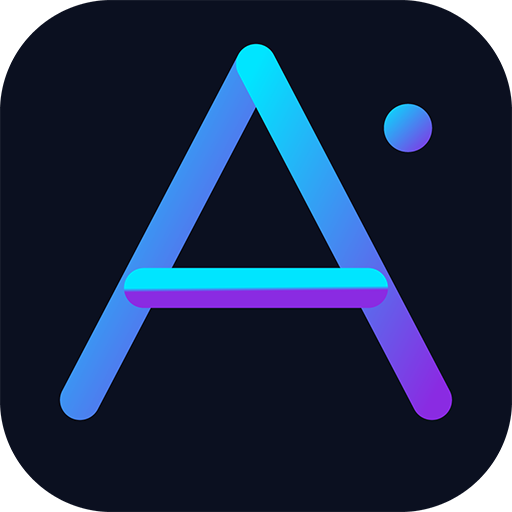

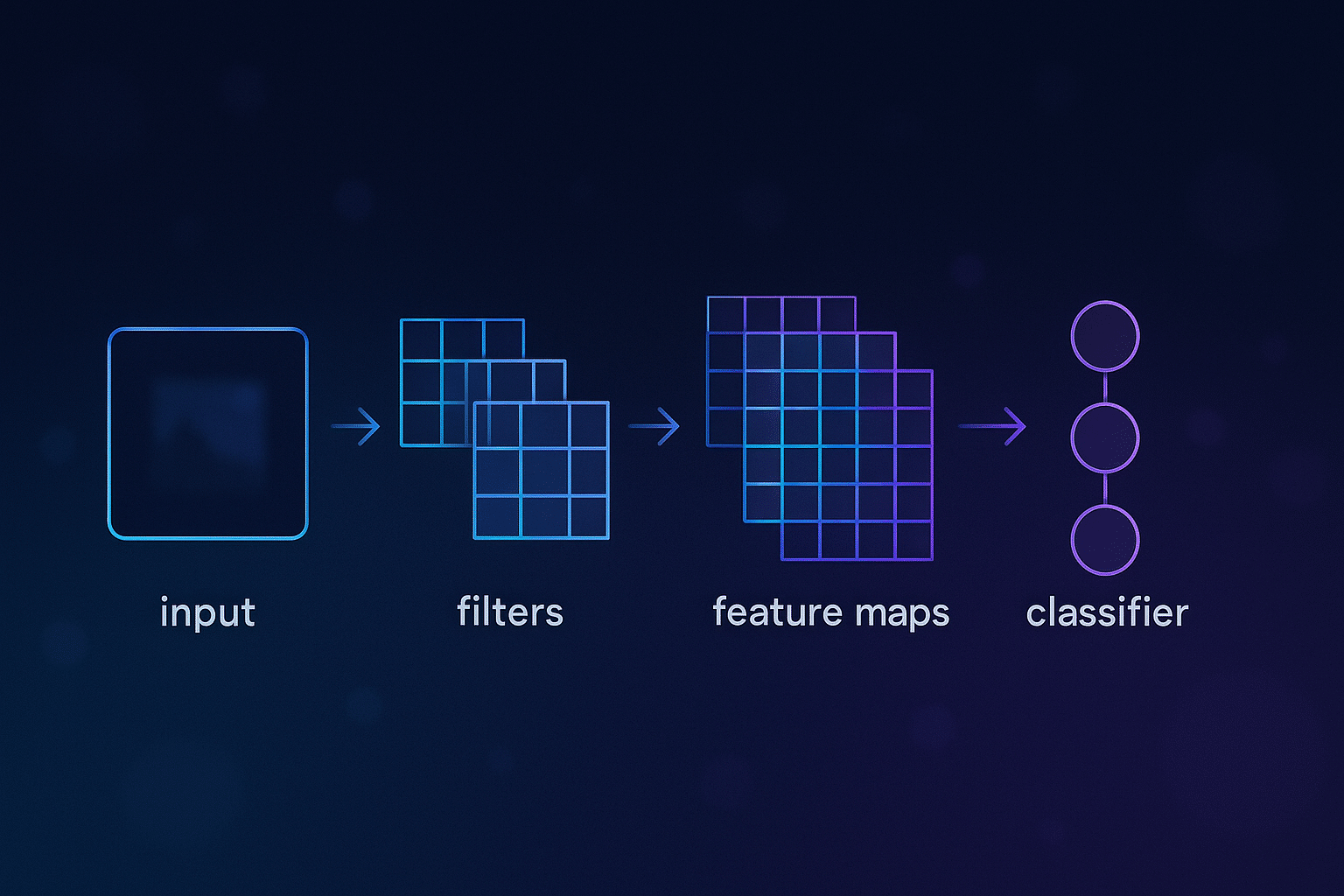
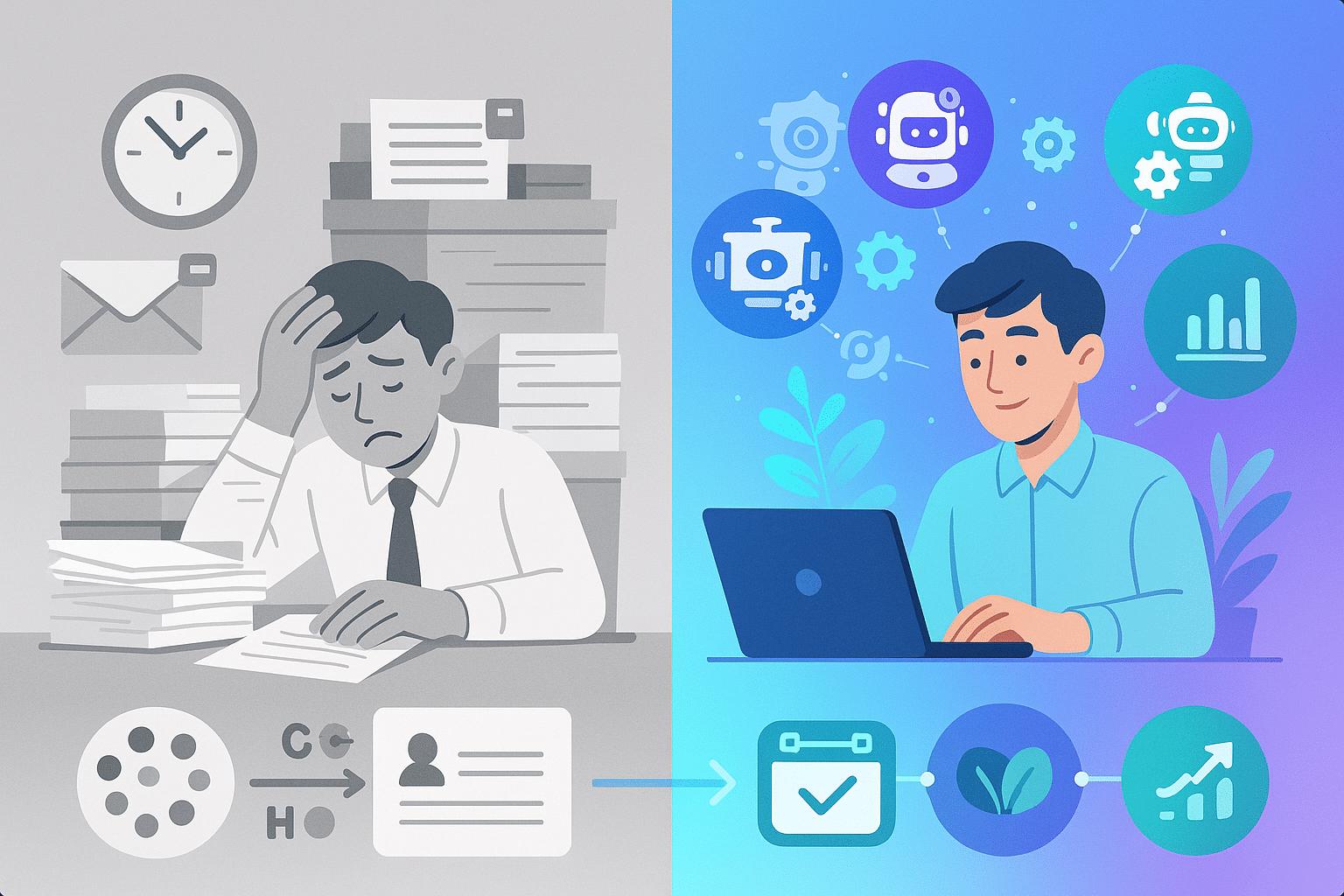
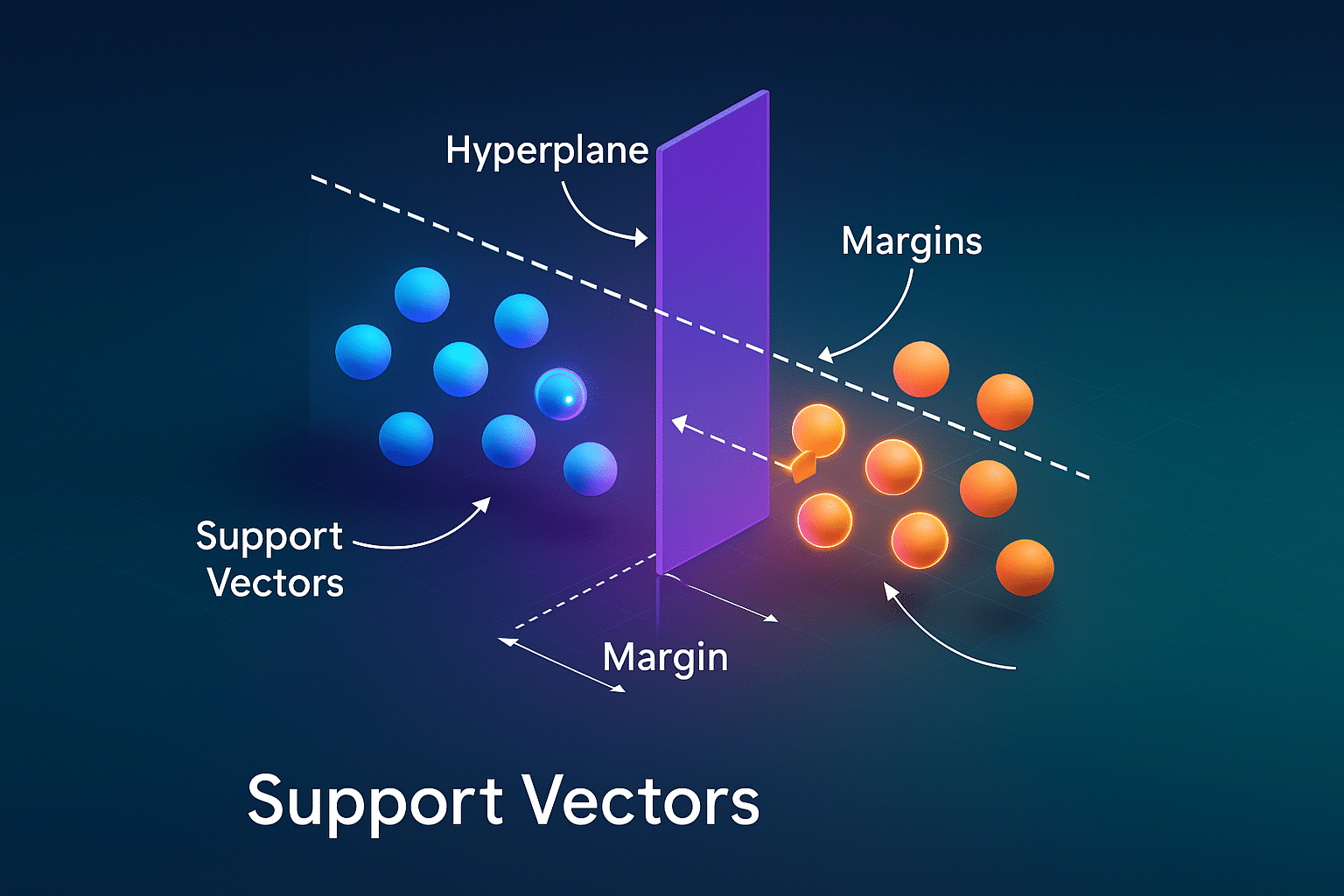
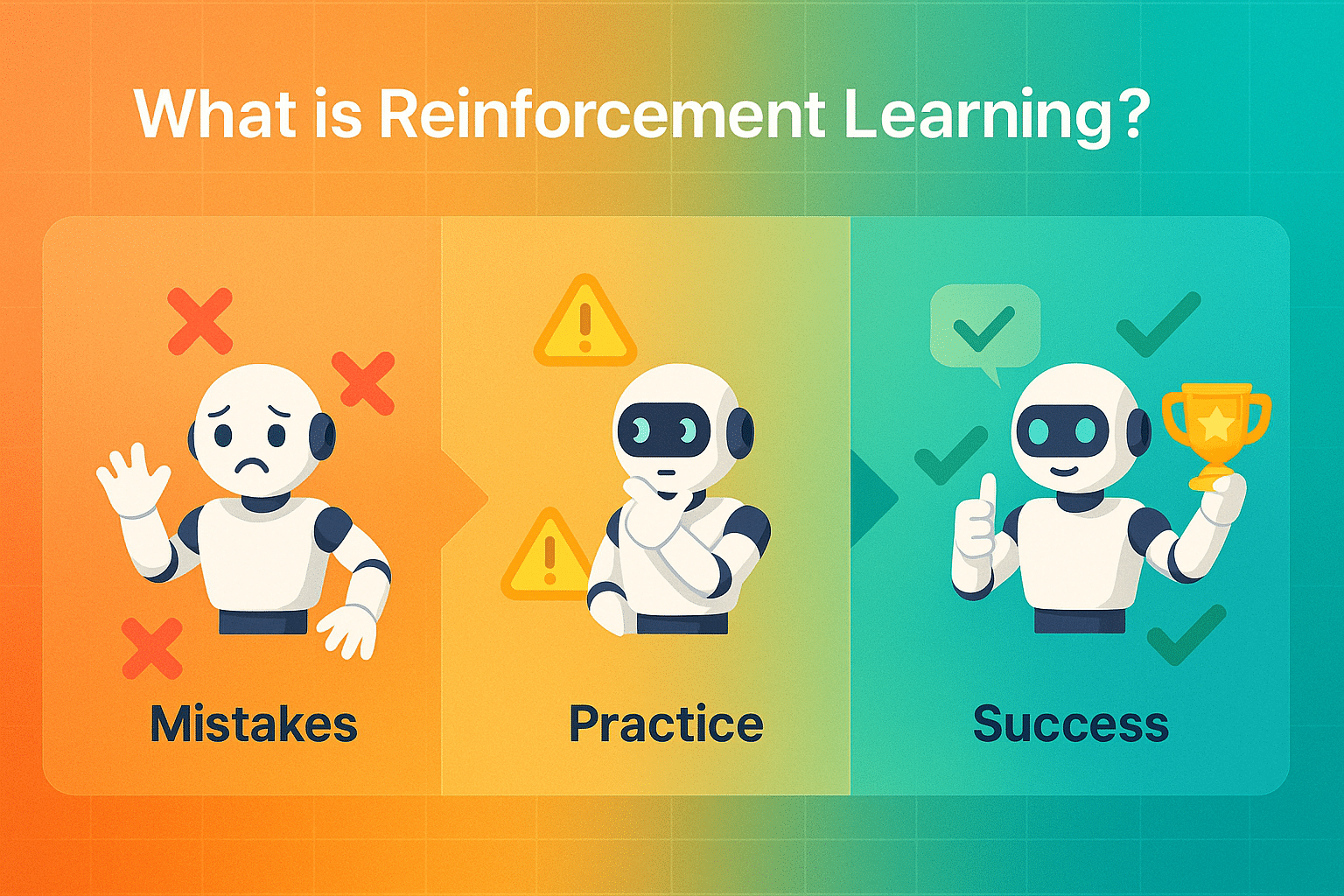
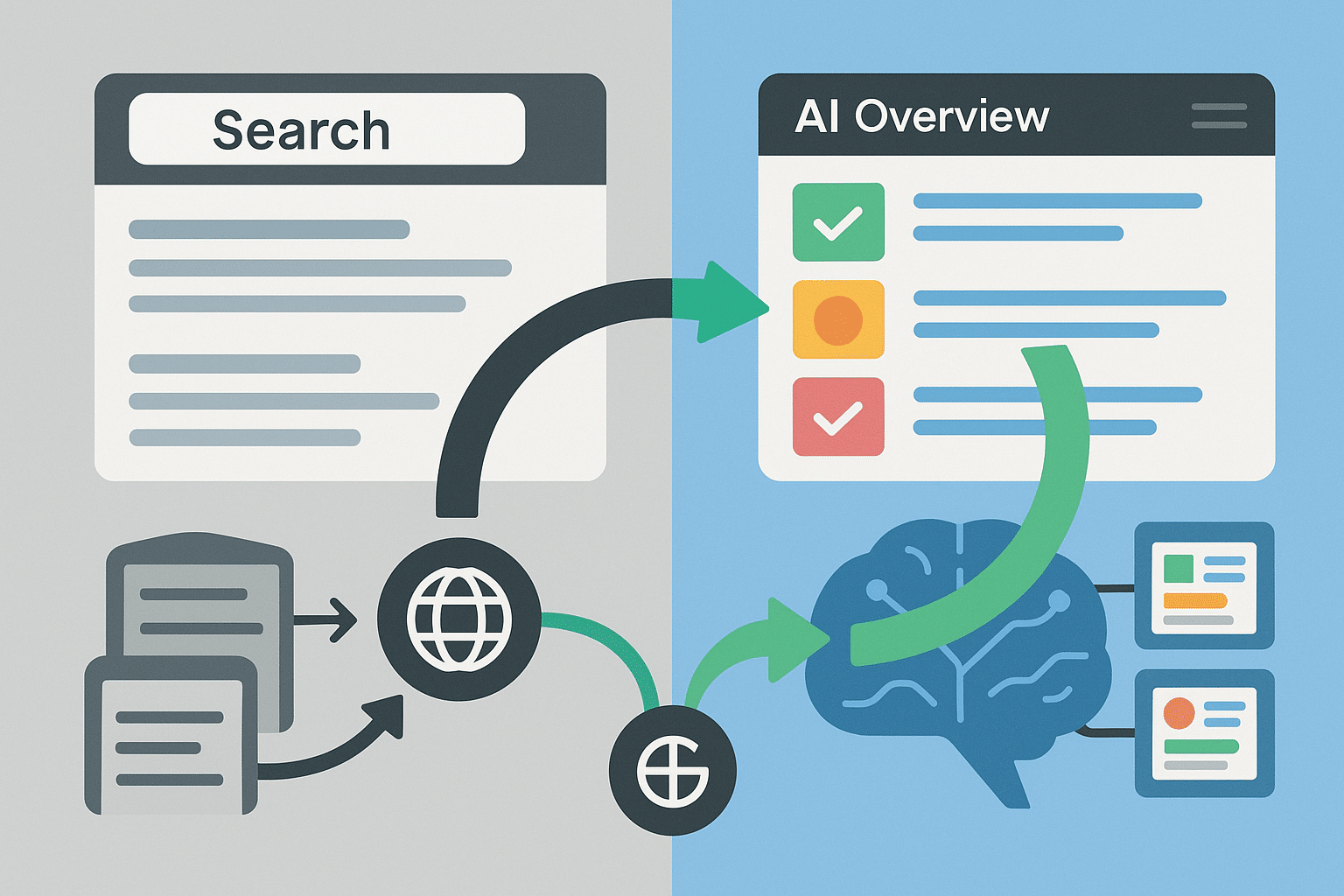
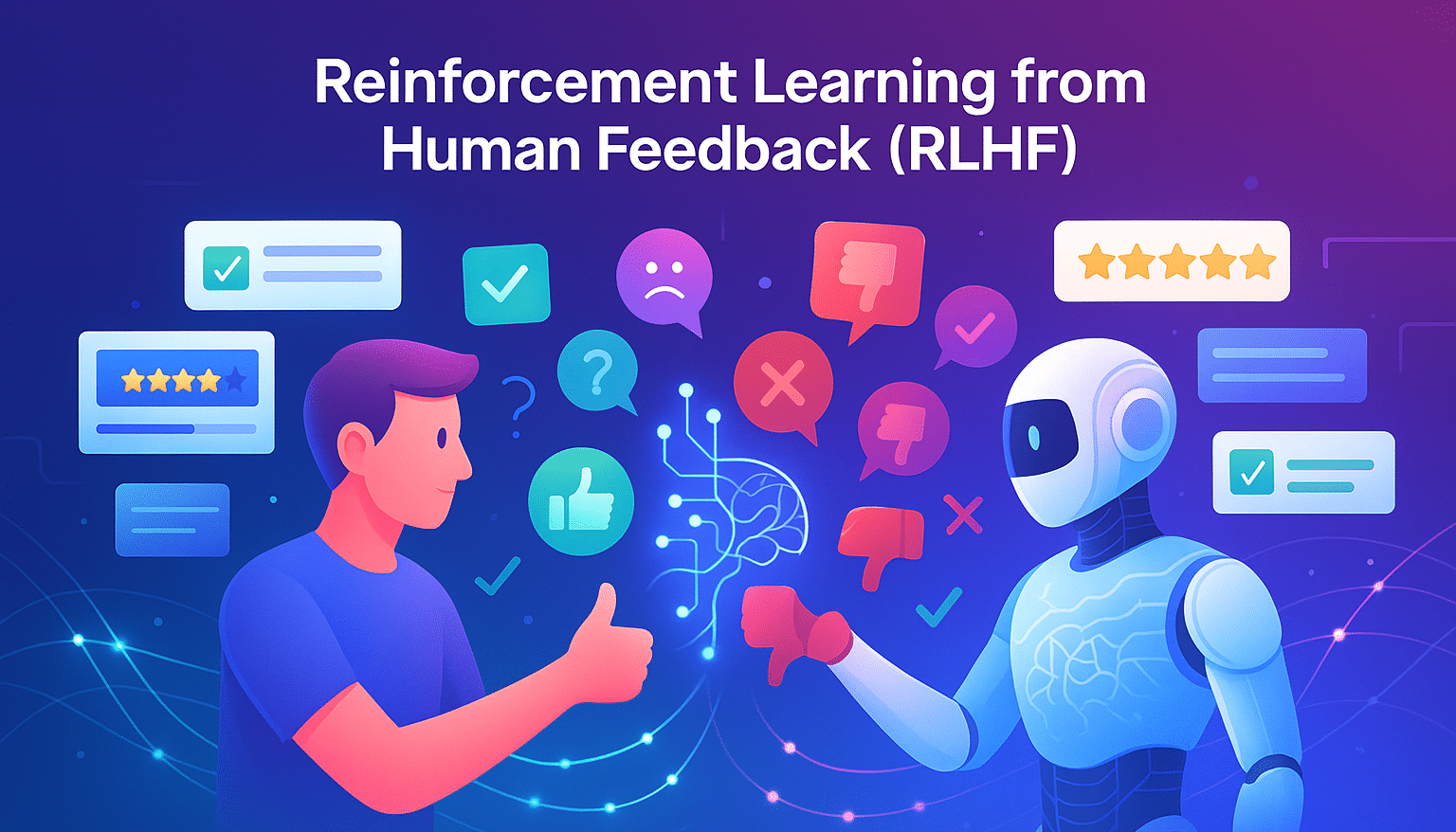
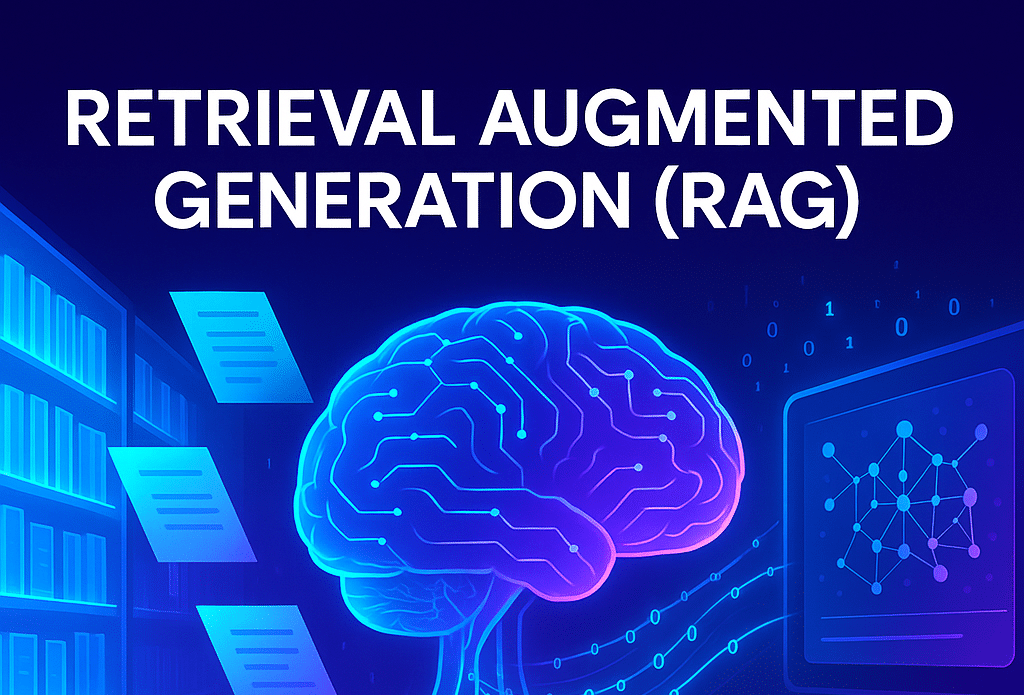
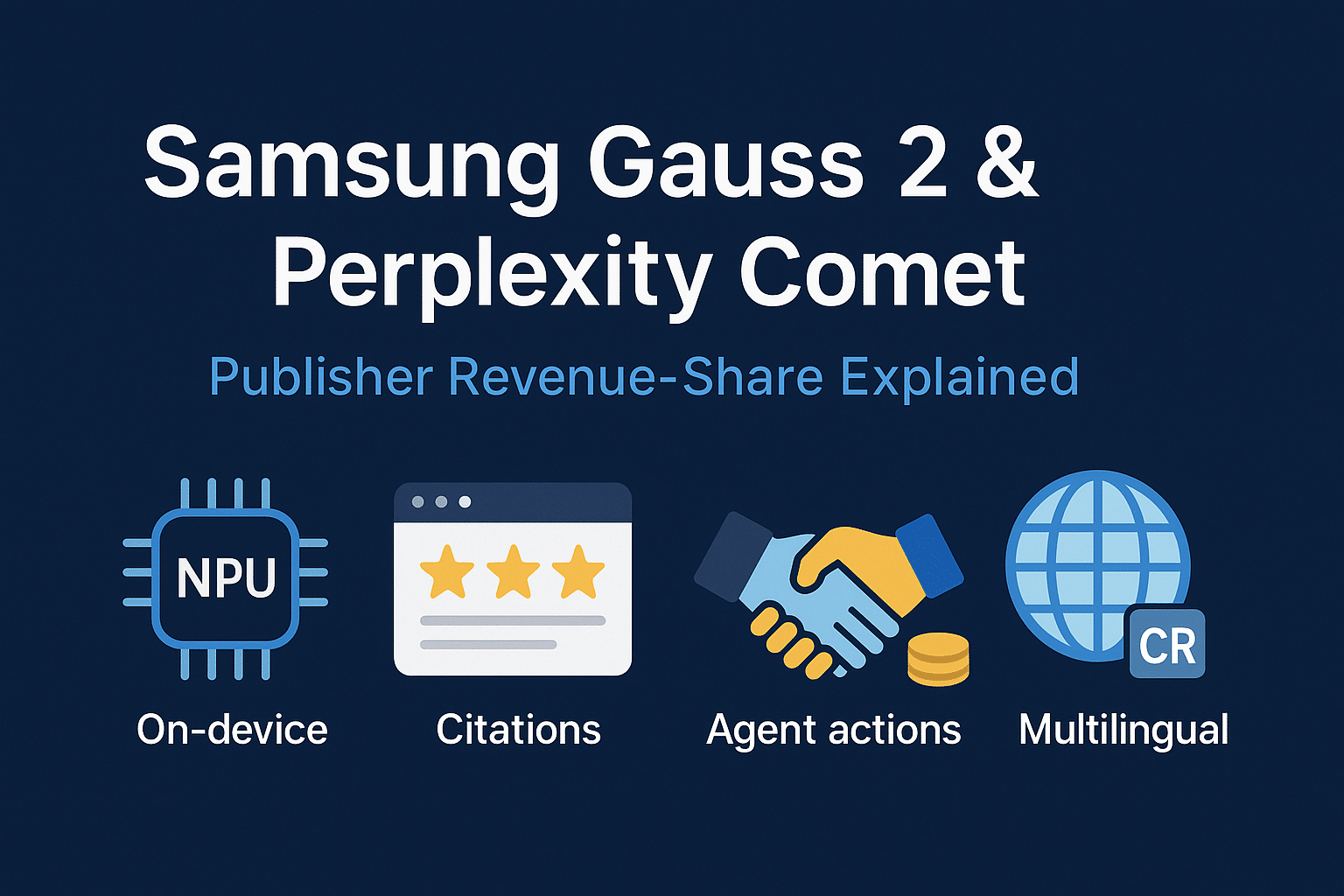
Leave a Reply